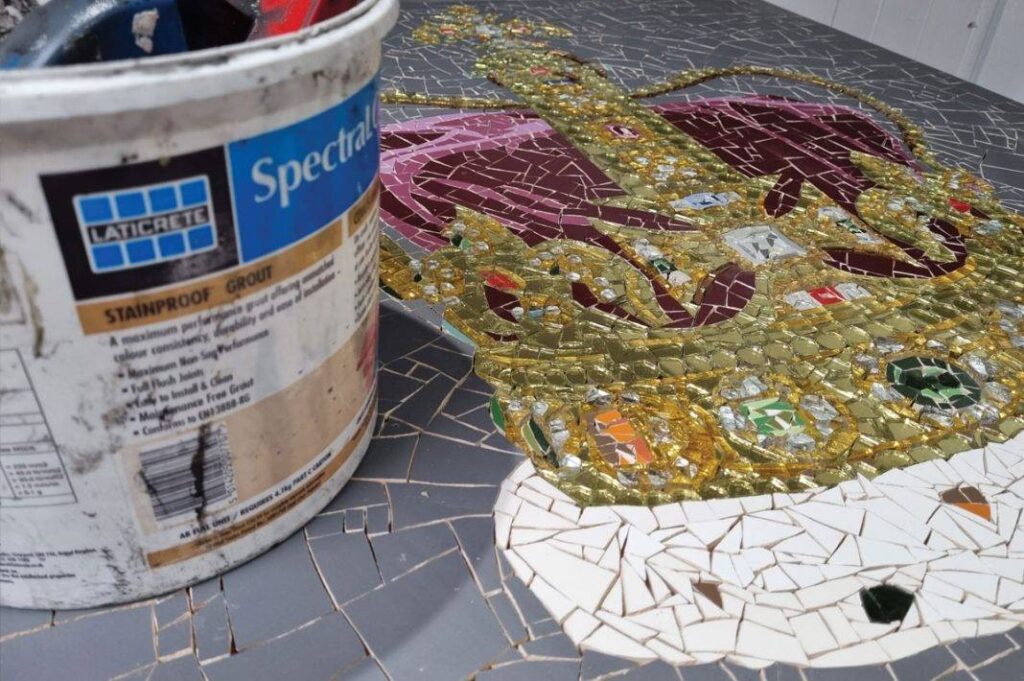When Manchester mosaic artist David Arnott began his expensive jewel encrusted mosaic artwork to mark the Queen’s Platinum Jubilee, he says, he could only dream that it would one day receive royal approval.
But that’s exactly what happened after he began research into his 3 x 3ft mosaic rendition of the St Edward’s Crown – the crown worn by Queen Elizabeth II during her coronation in 1953.
The piece was created for Clarendon Fine Art, the largest gallery chain in the UK, which sells art from the likes of Pablo Picasso, Andy Warhol and Salvador Dali, as well as many of Arnott’s other iconic mosaic works.
Well known for the hours of research he puts into his art before beginning the task of cutting and fitting thousands of tiny pieces of glass, tile, gold and anything else he deems appropriate to his current project, Arnott wrote to the royal household for some background history on the St Edward’s Crown.
When they learned Arnott was creating what he describes as ‘something very different’ to celebrate the Queen’s 70 years on the throne, he received a very helpful reply from the palace.
“Let’s just say they pointed me in the right place to get all the information I needed to produce something very different,” said Arnott. “I’ve done portraits of the Queen before, so I wanted to make this piece extra special. And I didn’t realise how much interesting history was behind this crown. Fingers crossed that the finished piece is fit for the Queen!”
While the depiction of the St Edward’s Crown may not hold the same priceless value as the crown itself, it was created using some very valuable materials. In addition to the tile pieces, notably in moleskin grey and royal purple, Arnott’s crown features gold glass, 24-carat gold pieces, diamond dust and 43 precious gemstones, including sapphires, amethyst, rubies and aquamarines. He even cut up a bottle of Veuve Clicquot champagne for the green elements within his design.
“It took a very long time,” said Arnott. “The gold I was using was particularly difficult to work with. And I didn’t want the crown to look two-dimensional, so I effectively created two crowns on top of each other, with a layer of gold underneath to raise it slightly from the ceramic to make it stand out more.
But although it was probably my most tasking piece yet, it was very enjoyable to do, and the process even increased my admiration for the Queen”.
The 35-year-old artist turned to Liverpool-based Palace Chemicals to supply the adhesive, grouting and sealant products for the project.
Arnott says he will only use Palace Grab & Fix MS polymer adhesive for his high value works. “You know that if you use it, it’s going to last,” he said. “I’ve never had any problems at all with it – it’s the best adhesive out there”.
He also used Palace Fix & Seal – a high modulus, polyurethane hybrid-based sealant and adhesive that reportedly cures on exposure to moisture and remains highly elastic. For the grouting, Arnott used a combination of Laticrete Spectralock (also supplied by Palace) and Palace’s Colour-Lock Grout – using the platinum version as a nod to the Queen’s momentous occasion.
David said: “It had to be platinum. It was perfect, especially as the crown is set on an all-grey background”.
Colour-Lock Grout is a polymer-fortified, mould resistant grout based on lime-free binder technology, designed to ensure the finished colour shade is consistently achieved without being affected by efflorescence or shade variation. It’s available in 11 colours, typically for wall and floor tile joints up to 20mm.
Spectralock Pro Premium Grout is a patented three-part grout offering colour uniformity, durability, stain protection and full grout joints in an easy-to-use, non-sag formula, Palace says.
Charles Clapham, MD of Palace Chemicals, said: “David’s mosaics are masterpieces in every sense, and we are always delighted to see the results of his latest works and we’re extremely proud to play a role in their completion.
“To learn that his Jubilee crown mosaic might even be seen by the Queen herself really is icing on the cake. What a very special way to mark a very special occasion”.
As one of the world’s biggest collectors of art, it is not known whether the Queen or her royal household might bid to purchase David’s latest artwork, but he is nevertheless delighted that it will at least receive the royal gaze.





